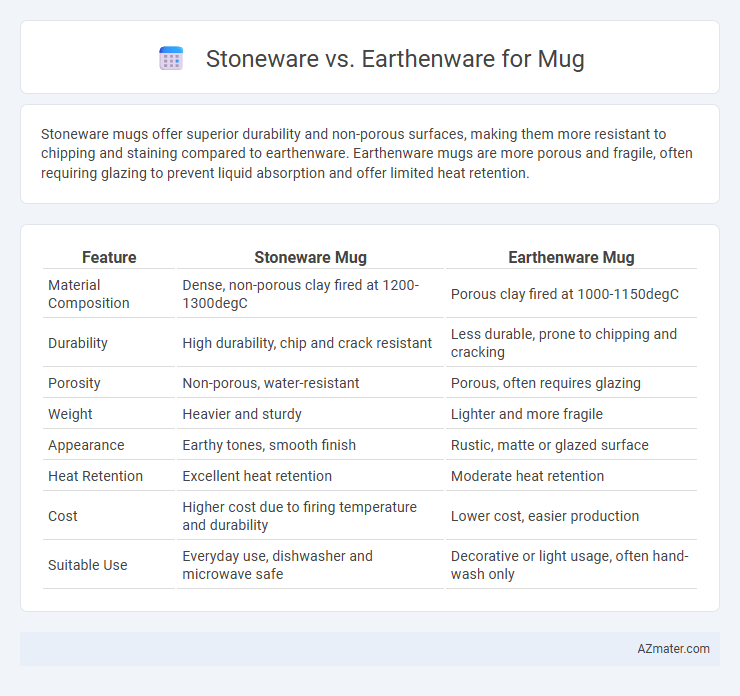Stoneware mugs offer superior durability and non-porous surfaces, making them more resistant to chipping and staining compared to earthenware. Earthenware mugs are more porous and fragile, often requiring glazing to prevent liquid absorption and offer limited heat retention.
Table of Comparison
| Feature | Stoneware Mug | Earthenware Mug |
|---|---|---|
| Material Composition | Dense, non-porous clay fired at 1200-1300degC | Porous clay fired at 1000-1150degC |
| Durability | High durability, chip and crack resistant | Less durable, prone to chipping and cracking |
| Porosity | Non-porous, water-resistant | Porous, often requires glazing |
| Weight | Heavier and sturdy | Lighter and more fragile |
| Appearance | Earthy tones, smooth finish | Rustic, matte or glazed surface |
| Heat Retention | Excellent heat retention | Moderate heat retention |
| Cost | Higher cost due to firing temperature and durability | Lower cost, easier production |
| Suitable Use | Everyday use, dishwasher and microwave safe | Decorative or light usage, often hand-wash only |
Introduction: Comparing Stoneware and Earthenware Mugs
Stoneware mugs are dense, non-porous, and fired at higher temperatures, making them more durable and resistant to chipping compared to earthenware mugs. Earthenware mugs, fired at lower temperatures, are more porous and lightweight but require glazing to prevent liquid absorption. Both materials offer unique aesthetic qualities, with stoneware providing a rustic, sturdy feel and earthenware showcasing vibrant glazes and delicate designs.
Key Differences Between Stoneware and Earthenware
Stoneware mugs are fired at higher temperatures, typically between 1,200degC to 1,300degC, resulting in a dense, non-porous, and more durable material compared to earthenware, which is fired at lower temperatures around 1,000degC to 1,150degC and remains more porous and susceptible to chipping. The glaze on stoneware is usually thicker and more vitrified, providing better resistance to stains and heat, while earthenware has a more porous surface that may absorb liquids and odors without glazing. Stoneware's robust nature makes it ideal for everyday use due to its strength and heat retention, whereas earthenware often offers a rustic aesthetic but requires more careful handling and maintenance.
Durability: Which Mug Material Lasts Longer?
Stoneware mugs exhibit superior durability compared to earthenware due to their dense, non-porous composition and higher firing temperatures, which enhance resistance to chipping and cracking. Earthenware mugs, fired at lower temperatures, tend to be more porous and fragile, making them more susceptible to breakage over time. For long-lasting use, stoneware is the preferred choice, offering better longevity and resilience in daily mug use.
Heat Retention: Best for Hot Beverages
Stoneware mugs excel in heat retention due to their dense, non-porous composition, keeping hot beverages warmer for longer periods. Earthenware mugs, while charming and often more porous, tend to lose heat faster, making them less ideal for maintaining beverage temperature. For those prioritizing warmth and insulation in a mug, stoneware remains the superior choice for hot drinks like coffee or tea.
Porosity and Water Absorption Comparison
Stoneware exhibits lower porosity and water absorption rates compared to earthenware, making it more durable and less prone to leakage or staining when used for mugs. Earthenware typically has higher porosity, which results in greater water absorption and requires glazing to prevent seepage and enhance strength. The dense composition of stoneware ensures mugs retain heat longer and resist chipping, while earthenware remains more porous and fragile.
Aesthetic Appeal: Colors, Textures, and Finishes
Stoneware mugs feature a dense, durable composition that allows for rich, earthy tones and smooth, often glossy finishes, enhancing their rustic and sophisticated aesthetic appeal. Earthenware mugs, characterized by their porous and lighter clay body, offer a wider range of vibrant colors and matte or textured finishes that emphasize craftsmanship and artisanal charm. The choice between stoneware and earthenware determines the mug's tactile experience and visual depth, with stoneware's refined glazes contrasting earthenware's natural, handcrafted look.
Microwave and Dishwasher Safety
Stoneware mugs are typically oven, microwave, and dishwasher safe due to their dense, non-porous structure that withstands high heat and moisture without cracking. Earthenware mugs, being more porous and often glazed with less durable finishes, may absorb moisture, making them less reliable in microwave and dishwasher environments and prone to chipping or cracking. Choosing stoneware ensures better safety and longevity for microwave and dishwasher use compared to earthenware.
Sustainability and Environmental Impact
Stoneware mugs offer greater durability and longer lifecycle compared to earthenware, reducing waste and the need for frequent replacements, which supports sustainability goals. Earthenware, often fired at lower temperatures, consumes less energy during production but tends to be more porous and fragile, leading to shorter product lifespan and potentially higher environmental impact over time. Choosing stoneware with natural, non-toxic glazes enhances eco-friendliness by minimizing chemical leaching and promoting reuse, aligning with environmentally conscious consumer practices.
Price and Accessibility of Stoneware vs. Earthenware Mugs
Stoneware mugs generally have a higher price point than earthenware due to their denser, more durable composition and higher firing temperatures. Earthenware mugs are often more accessible and affordable, commonly found in local markets and beginner pottery collections. While stoneware offers longevity and resistance to chipping, earthenware's lower cost makes it an attractive option for budget-conscious buyers.
Choosing the Right Mug for Your Needs
Stoneware mugs offer superior durability and heat retention compared to earthenware, making them ideal for daily use and hot beverages. Earthenware mugs, lighter and often more porous, provide an affordable, artisanal aesthetic suitable for decorative or occasional use. Selecting between stoneware and earthenware depends on balancing durability, heat retention, and design preference to match your drinking habits and lifestyle.

Infographic: Stoneware vs Earthenware for Mug
 azmater.com
azmater.com